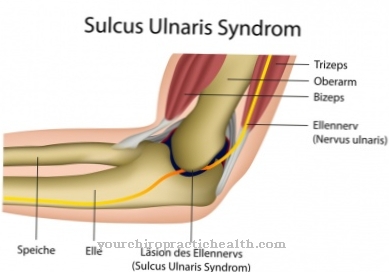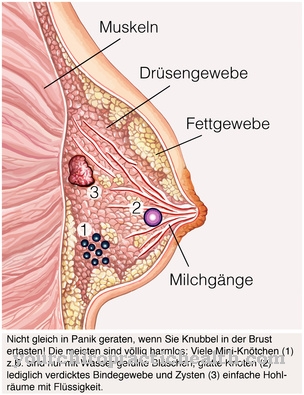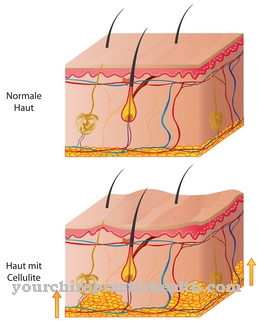The Morton's neuralgia is a neurological disorder that typically occurs in the forefoot area. The disease is also known as Morton's neuroma.
What is Morton's Neuralgia?

© Oranuch - stock.adobe.com
The so-called causal pain of Morton's neuroma is located between the second and third but also between the fourth and fifth toes. Morton's neuralgia usually only occurs on one foot, but case reports have also been described in which both feet are affected.
Morton's neuralgia is characterized by so-called neuralgic pain. The affected patients describe these pain attacks as electrifying, burning, shooting and stabbing. In addition, the vast majority of those affected describe pain radiating to the tip of the toe of the affected foot.
Morton's neuralgia is caused by the neuroma; it is a neural tumor, a fiber-like thickening of the nerves, starting from the ball of the foot between the metatarsal heads and branching into the toes. At these branches, between the second and third or the fourth and fifth toe, the benign neural tumor, the neuroma, forms.
causes
The cause of the pronounced thickening of the nerve cord is the body's own protective mechanism for enveloping the nerve so that it can no longer inflame. The so-called plantar nerves are located in the sole of the foot.
The plantar nerves branch finely down to the individual toes, where they branch and divide and finally end as fine nerve fibers on the inside of the toes. The exact causes that lead to Morton's neuralgia are not clearly known. However, there are a number of factors that are suspected of promoting the disease. In addition to the genetic predisposition of weak connective tissue, high heels, splayfoot, narrow, sturdy shoes or heavy loads on the feet from constant long walking or standing are risk factors.
Biomechanical dysfunction caused by flat feet can apparently also cause Morton's neuralgia. The flat feet, on the other hand, are not infrequently the result of years of obesity.
Symptoms, ailments & signs
Morton's neuralgia initially manifests itself through unspecific numbness or strange feelings in different parts of the body. Typical discomforts include the "ant running" in the toes and foreign body sensations in the shoe. These sensations are often accompanied by pain, which can vary depending on the severity and localization of the disease.
Stress-dependent pain that subsides immediately after taking off the shoes is possible, but also sharp pain that lingers for a long time. However, symptoms generally improve when the patient sits down or takes off their shoes and socks. In addition, the sick are less resilient and often have to take breaks.
The pain is usually one-sided, in a few patients the symptoms can be felt in both feet. The pain itself is described by those affected as stabbing or throbbing. Externally, the Morton's neuralgia can be recognized by any malformations.
A splayfoot can be present that can be diagnosed based on the abnormal position of the toes. Morton's neuralgia sets in over the course of several months and slowly subsides with appropriate treatment. If there is insufficient therapy, the symptoms increase and secondary diseases such as metatarsalgia develop.
Diagnosis & course
The diagnosis is based initially on the collection of the medical history, anamnesis, and querying the risk factors. If, for example, sturdy, narrow shoes are the cause of Morton's neuralgia, the feet had no way of rolling forward because the forefoot part was made much too narrow.
This results in nerve compression, i.e. the nerve is permanently trapped between the bony structures and becomes inflamed as a result. Morton's neuralgia can also be an occupational disease if the job requires constant long walking or standing with the wrong footwear. If the cause is very high heels, the body weight is constantly shifting to the forefoot and gradually a splayfoot can develop.
In addition to inspection and palpation of the foot, a conventional X-ray is usually also taken to confirm the suspected diagnosis. Morton's neuralgia occurs predominantly in women and the onset of the disease is gradual. If not treated in time, the course can also be chronic, especially if both feet are affected.
Complications
Morton's neuralgia mainly causes discomfort in the patient's feet. The feet can be painful and have severe swelling. The pain can also occur in the form of pain at rest and lead to sleep disorders or other sleep problems at night. As a result, patients often suffer from psychological complaints or depression and the quality of life is significantly reduced by Morton's neuralgia.
The patient's resilience also drops and there are restrictions on movement and gait disorders. In particular, severe pain occurs during exercise. Morton's neuralgia does not heal by itself, so medical treatment for this disease is definitely necessary. The foot can also be misaligned. If the nerve is pinched, the feet can also be affected by paralysis and other disorders of sensitivity.
A causal treatment of Morton's neuralgia is not possible. However, the symptoms can be alleviated with medication and with special shoes and insoles. Complications usually do not occur and the life expectancy of the patient is not reduced by Morton's neuralgia. Not all complaints can be limited in every case, meaning that patients may have to rely on the therapies for their entire lives.
When should you go to the doctor?
Pain in the foot that is not directly related to excessive strain or physical overexertion should be examined and treated by a doctor. If the pain increases, medical care is required. Due to possible side effects, you should generally refrain from taking pain relievers until you have consulted a doctor. Sudden, sharp pain in the foot is characteristic of Morton's neuralgia and should be seen to a doctor immediately.
If the physical exertion limit falls, if there is a decrease in performance or if the person concerned suffers from restricted mobility, a doctor is required. A doctor should be consulted if the pelvis is incorrectly posture, a crooked posture or any other abnormality in the skeletal system. Without an early correction, the person concerned threatens life-long damage and complaints. If the daily demands can no longer be perceived as usual, if behavioral problems occur and general well-being decreases, medical help must be sought.
In the event of visual changes in the foot, peculiarities of the skin and disorders of the blood circulation, a visit to a doctor is advisable. Sensitivity and sensation disorders, numbness or irregularities in relation to temperature influences in the foot should be assessed and treated by a doctor.
Treatment & Therapy
A strictly causal, i.e. cause-related treatment of Morton's neuralgia is not possible because the exact cause of the disease is not yet known. In most cases, however, a remedy can be found through individual knowledge of the risk factors.
However, since Morton's neuralgia tends to become chronic, these beneficial factors must be avoided permanently after the diagnosis has been made. Therapy is usually not necessary in milder cases. Morton's neuromas should always be treated when pain occurs, activities can only be carried out to a limited extent, there are difficulties in wearing shoes or the ability to walk is already restricted. In principle, Morton's neuralgia can be treated conservatively or surgically, depending on its severity and severity.
In the vast majority of cases, conservative therapy is attempted before a surgical intervention. This can consist of wearing specially made, orthopedic shoes or special insoles to support the entire foot. So-called pads are elevations that are supposed to relieve the forefoot when walking. Regular foot exercises or the injection of local anesthetics directly into the affected foot areas are also suitable for pain relief.
If all conservative measures do not bring lasting pain relief, an operation is inevitable. The neuroma, i.e. the benign neural tumor, can be completely removed. However, even after the operation, it cannot be ruled out that the tumor will grow back in the same place.
Outlook & forecast
The prognosis for Morton's neuralgia is very individual with conservative treatment. Very often, however, a noticeable improvement can be achieved with the simplest relief measures. The feeling of pain can occasionally still occur in the patient, but then only with greater stress. If Morton's neuralgia has progressed so far that stabbing pain is felt permanently, conservative therapy usually brings noticeable relief very quickly.
Spontaneous healing is sometimes possible in Morton's neuralgia. Therapy can lead to complete healing over a period of a few weeks or months. However, there are patients who do not respond to these therapy methods and therefore cannot be relieved of their pain.
Morton's neuralgia can affect a person several times in a lifetime. Accordingly, no one is exhausted after therapy for this. There seem to be certain factors that increase your risk of recurrence.
In any case, what permanently relieves the pain in the foot is the surgical procedure to remove the nerve tissue involved. If the nerves involved are missing, pain stimuli can no longer be sent to the brain. There is thus permanent freedom from pain.
prevention
To prevent a recurrence of Morton's neuroma after a successful operation, targeted foot exercises, foot baths with anti-inflammatory agents and elevation of the legs are required, which should be practiced every now and then during the day.
General prevention includes consistently avoiding the risk factors that would promote the occurrence of Morton's neuralgia. These include comfortable, not too tight footwear, avoiding or reducing excess weight, reducing the strain caused by walking or standing for too long and strengthening the connective tissue in the event of genetic disposition.
Aftercare
In most cases, the affected person has only limited follow-up measures available for Morton's neuralgia. The person concerned should first and foremost consult a doctor at an early stage so that there are no further complications or other complaints for the person concerned. The earlier a doctor is consulted, the better the further course of the disease usually is.
Therefore, the person affected should contact a doctor at the first signs of the disease. Most patients are dependent on a surgical procedure, which can permanently alleviate the symptoms. After such an operation, the person concerned should definitely rest and take care of his body. Exertion or physical and stressful activities should be avoided in order not to unnecessarily burden the body.
Physiotherapy or physiotherapy may also be necessary, whereby the person affected can also perform many of the exercises in their own home to speed up the treatment. Even after a successful operation, regular checks and examinations are important in order to monitor the current status of Morton's neuralgia. As a rule, this disease does not reduce the patient's life expectancy.
You can do that yourself
The disease has a worsened course of the disease in patients who increasingly suffer from mental or emotional stress. A good mental stability should therefore be established and maintained. The inner stress experience can be reduced through the use of mental techniques.
Methods such as yoga, autogenic training or meditation have proven successful. It is also helpful if everyday life is structured in such a way that as little restlessness or excitement as possible develops. Conflicts and disagreements should be avoided or resolved constructively so that emotional relief occurs. A fundamentally positive attitude towards life and living conditions is helpful in coping with the impairments. The use of pain reliever medication should be reduced if possible or only used temporarily. The active ingredients of the drugs trigger side effects and there is a risk of addiction. The symptoms can be alleviated using alternative healing methods or the relaxation techniques described.
Obesity should be avoided in patients with Morton's neuralgia. With a healthy and balanced diet, the organism can be supplied with all the necessary vitamins and nutrients. The weight should ideally be in the normal range according to the specifications of the BMI. Gaining weight or being overweight leads to deterioration in health as pain and restricted mobility increase.


.jpg)










.jpg)

.jpg)
.jpg)











.jpg)